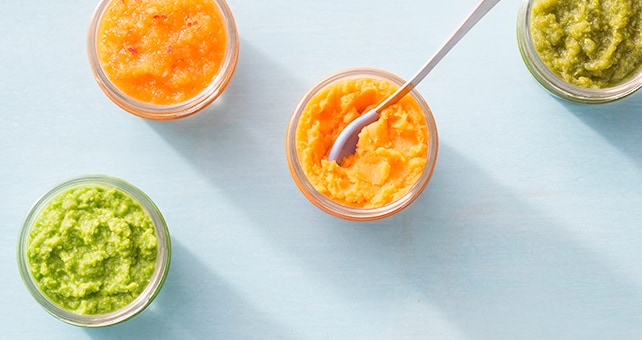Making your own baby food is easy (and economical) once you master the basics of homemade purees. This primer can have you on your way in no time.
Before you begin, confirm that your baby is developmentally ready for solid foods with the help of our guide.
Supplies
- Food processor or blender
- Small sealable baby food storage containers
- Ice cube trays (for freezing extra baby food)
- Plastic freezer bags (for storing frozen portions of baby food)
- Spatula
Suggested fruits*
- Apples
- Pears
- Bananas
- Peaches
Suggested veggies*
- Green beans
- Peas
- Sweet Potatoes
Sources:
"Home-Prepared Baby Food.” USDA.
"Working Together: Breastfeeding and Solid Foods.” HealthyChildren.org. November 21, 2015.
"Starting Solid Foods.” HealthyChildren.org. March 8, 2017.
"Feeding Solid Foods.” USDA.
How to puree
Step 1. Start with fresh fruits and vegetables that have been washed and dried. Peel foods with thicker skins, such as sweet potatoes and butternut squash. Fruits with thinner peels, such as apples and pears, can be pureed with the peel on for greater nutritional value.
Step 2. Cut your fruits and veggies into small cubes, and steam or simmer in water until very tender.
Step 3. Drain and place in a food processor or blender.
Step 4. Blend or process until very smooth. As your baby gets older, you can process slightly less to retain some of the food's texture.
Tip: Start with fruit and vegetable purees that are thinner in consistency. Use water, breast milk, or formula to thin the purees to reach the desired consistency after blending.
Sources:
"Home-Prepared Baby Food.” USDA.
"Making Baby Food with Fruits and Vegetables!" IN.gov. February 2010.
Storage
Stay food-safe by storing homemade baby food in the refrigerator for up to two days, and in the freezer for up to one month. Individual portions of baby food can be frozen in ice cube trays. Once frozen, transfer the baby food to a plastic freezer bag labeled with your baby's name and the date the baby food was made.
Sources:
"Home-Prepared Baby Food.” USDA.
"Making Baby Food with Fruits and Vegetables!" IN.gov. February 2010.
*NOTE: Introduce only one new food at a time. To make sure your child does not have a negative reaction, wait several days before you add another new food.
This content is provided for general information purposes only. It is not intended to be a substitute for medical advice or a guarantee of prevention, improvement, or treatment of specific conditions. Always consult with your healthcare provider about your specific medical questions or concerns.

 You are about to leave publix.com and enter the Instacart site that they operate and control. Publix’s delivery and curbside pickup item prices are higher than item prices in physical store locations. Prices are based on data collected in store and are subject to delays and errors. Fees, tips & taxes may apply. Subject to terms & availability. Publix Liquors orders cannot be combined with grocery delivery. Drink Responsibly. Be 21. For prescription delivery, log in to your pharmacy account by using the Publix Pharmacy app or visiting
You are about to leave publix.com and enter the Instacart site that they operate and control. Publix’s delivery and curbside pickup item prices are higher than item prices in physical store locations. Prices are based on data collected in store and are subject to delays and errors. Fees, tips & taxes may apply. Subject to terms & availability. Publix Liquors orders cannot be combined with grocery delivery. Drink Responsibly. Be 21. For prescription delivery, log in to your pharmacy account by using the Publix Pharmacy app or visiting 